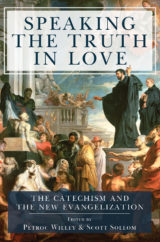By Brad Bursa
Brad Bursa is the Director of the Office for Youth Evangelization and Discipleship for the Archdiocese of Cincinnati. He contributed to Speaking the Truth in Love: The Catechism and the New Evangelization.

Joseph Ratzinger, now Pope Emeritus Benedict XVI, personifies true reform in the image of “the wonderer.” He notes that this sense of wonder, when it comes to ecclesial renewal, lies in the realization that the Church is not something made by men, but is “given to us all.” The “wonderer” is not preoccupied with an overemphasis on the Church or idealistic visions of what the Church could be; rather, he consistently looks to God, unites himself to God, and desires that God be known today. Wonder says “no” to empirical confinement and “prepares man for the act of faith, which opens him to the horizon of the eternal and infinite. And only the unlimited is large enough for our nature and in accord with the call of our essential being.”
In a more recent address, Benedict XVI says, “The Church does not begin with our ‘making,’ but with the ‘making’ and ‘speaking’ of God.” The shift from making to receiving, from the realm of the building to the realm of gift, from the empirical to the realm of faith, cannot be overemphasized and has significant bearing on renewal. If the Church is not an object or organization made by the hands of men, but is given to men by God, then renewal cannot be handcrafted by men. Renewal must be received. Renewal cannot be contrived according to the ideals and tastes of men, it cannot be made by human hands; it is an event the Church opens herself to and begs for God to bring about in her, in his time, and in his way. If God creates the Church, then God must recreate the Church—renewing her in every age.
As he closes his address “A Company in Constant Renewal,” Ratzinger emphasizes the need for personal renewal, with a particular emphasis on one’s awareness that he stands in need of forgiveness and that this grace of forgiveness results in a desire to follow on the way of penance, the way of discipleship. Creation and renewal are wholly personal acts of the God who is three Persons in one God. Renewal does not come about by democratic election, proposed legislation, or human genius, but by the grace of God operative in the person who repents and believes.
Here, Ratzinger’s treatment of the saints and the call to holiness are particularly fitting. In The Ratzinger Report, he says, “Saints, in fact, reformed the Church in depth, not by working up plans for new structures, but by reforming themselves. What the Church needs in order to respond to the needs of man in every age is holiness, not management.” In saying this, Ratzinger is neither referencing the canonized saints, nor is he following Rahner’s well-known saying about the Christian of tomorrow needing to be a mystic or he will be without faith; rather, Ratzinger claims that Christianity will “be doomed to suffocation if we don’t learn something of interiorization, in which faith sinks personally into the depth of one’s own life and in that depth sustains and illuminates.” The act of faith expressed by and in the person, the saint who has encountered Christ, allows the person to become a point of reference capable of renewing the Church, and these saints who have been “inwardly seized by Christianity, who experience it as joy and hope, who have thus become lovers,” are what the Church stands urgently in need of in order to carry out her mission.
Interestingly enough, according to Ratzinger, true reform, personified by “the wonderer” both at the levels of structure and of the person, can be characterized by both discontinuity and continuity. With regard to discontinuity, Ratzinger introduces a metaphor taken from Michelangelo, that of the sculptor who sees in the stone an image lying in wait within, a pure image to be uncovered. The task, then, is simply removal, or ablatio. For Benedict XVI, ecclesial renewal is ablatio.
Authentic reform, according to Benedict XVI, is not about erecting new façades, or “remodeling” according to “our tastes,” but consists in letting go of the human structures, letting go of the “subsidiary constructions.” In this regard, renewal can rightly be said to admit of discontinuity. Subsidiary constructions that have become obsolete must be discontinued, whether on the level of structures, or on the level of the person who has lost focus and has built up himself instead of allowing himself to be made ever anew by the Lord.
You Might Also Like

Speaking the Truth in Love draws together a group of Catholic scholars and field practitioners to focus on the capacity of the Catechism to be a powerful point for the renewal of Christian catechesis, education, and culture through its reclamation of the Christian heritage, its explanatory power, and its compelling articulation of a civilization characterized by faith, hope, and love.